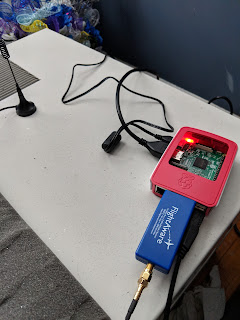My own virtual radar
I'm an avgeek, so I recently setup my own Automatic dependent surveillance – broadcast or ASD-B receiver. There are plenty around. The most common setup is to use a Raspberry Pi with a PiAware image on an SD card, an RTL-SDR and a 1090 MHz antenna. There are also more dedicated setups using hardware provided by the major ADS-B tracking websites such as FlightAware and Flightradar24.
I went the Pi route. However, instead of using the FlightAware PiAware image that's commonly available; I choose to run the ADS-B Receiver image by Joe Prochazka.
My setup consists of a Raspberry Pi 3B, a FlightAware Pro Stick Plus and a cheap $7 1090 MHz antenna. The Pro Stick Plus is nice because it's essentially a RTL-SDR USB dongle with a built in 1090MHz filter and RF amp. FlightAware also offers the regular Pro Stick which does not include a 1090 MHz filter.
I used the dump1090-flightaware version of the image, although it is available with another dump1090 version called dump1090-mutability. However, mutability himself says that version is outdated, deprecated and recommends using dump1090-flightaware.
I like the ADS-B Receiver image because not only does it include FlightAware feeding, but also includes clients for Flightradar24, Planefinder and what I think is the best of all the tracking sites: ADS-B Exchange which does not filter/block flights so you can see some pretty interesting results such as military flights and private jets that FlightAware and others have blocked because of requests by the owners of said jets.
It also has built in ADS-B UAT 978 MHz tracking using dump-978, something which I haven't set up yet. It also has a built in web portal, so I can make the setup publicly available, although it does rely on some port forwarding, but luckily Duck DNS is included on the image.
I was a little leery at first about setting it up because only the GitHub page was available and not the website that Joe had set up for it. However, a few days before I set up the Pi, it seems to have come back online and Joe says he's working hard on version 3.0 which will have it's own custom map optimized for both desktop and mobile instead of relying on the dump-1090 maps generated by the mutability and FlightAware versions.
Anyways, I've gotten pretty good results so far despite having a somewhat compromised location geographically and topographically as I've mentioned in a previous post.
I went the Pi route. However, instead of using the FlightAware PiAware image that's commonly available; I choose to run the ADS-B Receiver image by Joe Prochazka.
My setup consists of a Raspberry Pi 3B, a FlightAware Pro Stick Plus and a cheap $7 1090 MHz antenna. The Pro Stick Plus is nice because it's essentially a RTL-SDR USB dongle with a built in 1090MHz filter and RF amp. FlightAware also offers the regular Pro Stick which does not include a 1090 MHz filter.
I used the dump1090-flightaware version of the image, although it is available with another dump1090 version called dump1090-mutability. However, mutability himself says that version is outdated, deprecated and recommends using dump1090-flightaware.
I like the ADS-B Receiver image because not only does it include FlightAware feeding, but also includes clients for Flightradar24, Planefinder and what I think is the best of all the tracking sites: ADS-B Exchange which does not filter/block flights so you can see some pretty interesting results such as military flights and private jets that FlightAware and others have blocked because of requests by the owners of said jets.
It also has built in ADS-B UAT 978 MHz tracking using dump-978, something which I haven't set up yet. It also has a built in web portal, so I can make the setup publicly available, although it does rely on some port forwarding, but luckily Duck DNS is included on the image.
I was a little leery at first about setting it up because only the GitHub page was available and not the website that Joe had set up for it. However, a few days before I set up the Pi, it seems to have come back online and Joe says he's working hard on version 3.0 which will have it's own custom map optimized for both desktop and mobile instead of relying on the dump-1090 maps generated by the mutability and FlightAware versions.
Anyways, I've gotten pretty good results so far despite having a somewhat compromised location geographically and topographically as I've mentioned in a previous post.
Those weird squiggles are my line of sight range for the setup I have, plus a regular line of sight range. According to my FlightAware stats, most of the ADS-B packets received occur to the south of me, I get very little to the north.
So if you want to view my setup online, here's the links for the FlightAware map and the Planefinder map.





Comments
Post a Comment